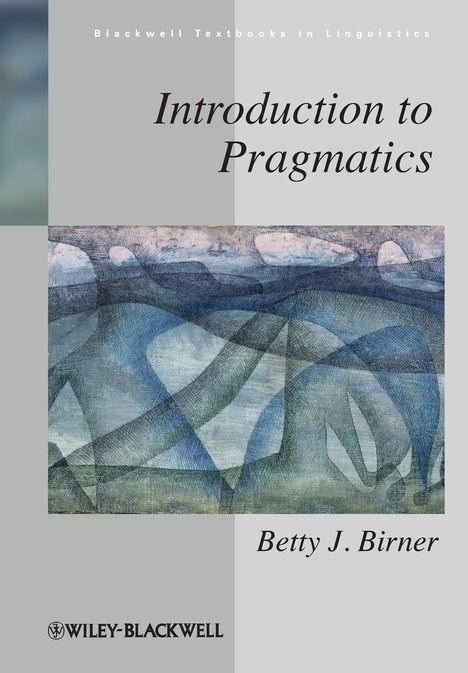Betty J. (Northern Illinois University Birner: Introduction to Pragmatics
Introduction to Pragmatics
Buch
- Verlag:
- John Wiley and Sons Ltd, 08/2012
- Einband:
- Kartoniert / Broschiert, Paperback
- Sprache:
- Englisch
- ISBN-13:
- 9781405175838
- Artikelnummer:
- 2888503
- Umfang:
- 352 Seiten
- Auflage:
- 1st ed.
- Copyright-Jahr:
- 2012
- Gewicht:
- 591 g
- Maße:
- 244 x 170 mm
- Stärke:
- 18 mm
- Artikelnummer:
- 2888503
- Erscheinungstermin:
- 17.8.2012
- Hinweis
-
Achtung: Artikel ist nicht in deutscher Sprache!
Weitere Ausgaben von Introduction to Pragmatics |
Preis |
|---|---|
| Buch, Kartoniert / Broschiert, Englisch | EUR 63,41* |
Beschreibung
Pragmatics is the study of language use in context. It concerns itself with the relationship between language and the humans who use it, and specifically how their beliefs and intentions affect both the form and the interpretation of their utterances. This introductory textbook presents an up-to-date survey of the field, addressing the traditional range of topics within pragmatics - such as implicature, reference, presupposition, and speech acts - as well as newer areas of research including neo-Gricean theories, Relevance Theory, information structure, inference, and dynamic approaches to meaning.Throughout the book the relationship between semantics and pragmatics is continually addressed and reassessed. By encompassing both traditional and new approaches, and focusing particularly on phenomena at the semantics / pragmatics boundary, Introduction to Pragmatics sheds light on one of the major issues in the field: the role of context in linguistic communication.
Inhaltsangabe
Preface xAcknowledgments xii
1 Defining Pragmatics 1
1.1 Pragmatics and Natural Language 2
1.2 The Boundary Between Semantics and Pragmatics 9
1.3 Summary 34
1.4 Exercises and Discussion Questions 36
2 Gricean Implicature 40
2.1 The Cooperative Principle 41
2.2 Types of Implicature 62
2.3 Testing for Implicature 68
2.4 The Gricean Model of Meaning 73
2.5 Summary 74
2.6 Exercises and Discussion Questions 75
3 Later Approaches to Implicature 77
3.1 Neo-Gricean Theory 77
3.2 Relevance Theory 91
3.3 Comparing Neo-Gricean Theory and Relevance Theory 98
3.4 Summary 107
3.5 Exercises and Discussion Questions 108
4 Reference 110
4.1 Referring Expressions 110
4.2 Deixis 114
4.3 Defi niteness and Indefi niteness 121
4.4 Anaphora 130
4.5 Referential and Attributive Uses of Defi nite Descriptions 138
4.6 Summary 142
4.7 Exercises and Discussion Questions 143
5 Presupposition 146
5.1 Presupposition, Negation, and Entailment 146
5.2 Presupposition Triggers 152
5.3 The Projection Problem 155
5.4 Defeasibility 157
5.5 Presupposition as Common Ground 163
5.6 Accommodation 167
5.7 Summary 172
5.8 Exercises and Discussion Questions 173
6 Speech Acts 175
6.1 Performative Utterances 175
6.2 Felicity Conditions 183
6.3 Locutionary Acts 186
6.4 Direct and Indirect Speech Acts 191
6.5 Face and Politeness 200
6.6 Joint Acts 202
6.7 Summary 203
6.8 Exercises and Discussion Questions 204
7 Information Structure 207
7.1 Topic and Focus 210
7.2 Open Propositions 215
7.3 Discourse-Status and Hearer-Status 217
7.4 Information Structure and Constituent Order 219
7.5 Functional Compositionality 229
7.6 Summary 235
7.7 Exercises and Discussion Questions 236
8 Inferential Relations 241
8.1 Inferential Relations at the Constituent Level 243
8.2 Inferential Relations at the Propositional Level 260
8.3 Summary 268
8.4 Exercises and Discussion Questions 269
9 Dynamic Semantics and the Representation of Discourse 271
9.1 Theoretical Background 272
9.2 Static vs. Dynamic Approaches to Meaning 276
9.3 Discourse Representation Theory 278
9.4 The Scope of DRT and the Domain of Pragmatics 284
9.5 Summary 290
9.6 Exercises and Discussion Questions 291
10 Conclusion 293
10.1 The Semantics / Pragmatics Boundary Revisited 294
10.2 Pragmatics in the Real World 296
10.3 Pragmatics and the Future of Linguistic Theory 302
10.4 Summary 304
10.5 Exercises and Discussion Questions 304
References 306
Sources for Examples 314
Index 318
Klappentext
Introduction to Pragmatics guides students through traditional and new approaches in the field, focusing particularly on phenomena at the elusive semantics / pragmatics boundary to explore the role of context in linguistic communication.* Offers students an accessible introduction and an up-to-date survey of the field, encompassing both established and new approaches to pragmatics
* Addresses the traditional range of topics - such as implicature, reference, presupposition, and speech acts - as well as newer areas of research, including neo-Gricean theories, Relevance
* Theory, information structure, inference, and dynamic approaches to meaning
* Explores the relationship and boundaries between semantics and pragmatics
* Ideal for students coming to pragmatics for the first time


